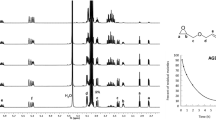Abstract
Novel trifunctional triazines (“TATORT reagents”) for the modification of cellulosic material were prepared from cyanuric chloride. The compounds employ a cellulose-reactive anchor group for fixation, an active substance showing slow release properties, and a reactivity tuner to facilitate release control. According to this approach, humidity acts as an external trigger to “switch on” the slow-release. While the release-compounds are completely stable under dry conditions, the active substances are released simply by surrounding moisture. The reactivity tuner controls the rate of the release: by choosing an appropriate tuner, the concentration maximum can be set anytime between minutes and several weeks. The release kinetics depends mainly on the structure of reactivity tuner and active substance, but only insignificantly on the type of the (cellulosic) carrier matrix. Apart from the inherent limitation to phenolic and carboxylic active substances, the approach is quite general as the active substances may encompass wide ranges of compounds and applications.













Similar content being viewed by others
References
Adorjan I, Sjöberg J, Rosenau T, Hofinger A, Kosma P (2004) Kinetic and chemical studies on the isomerization of monosaccharides in N-methylmorpholine-N-oxide (NMMO) under Lyocell conditions. Carbohydr Res 339:1899–1906
Akzo Nobel (1998) PCT Intl. Appl. 9803708, 17.07.1998
Barry BW (2001) Novel mechanisms and devices to enable successful transdermal drug delivery. Eur J Pharm Sci 14(2):101–114
Burchfield HP, Schuldt PH (1958) Pesticide analysis, pyridine-alkali reactions in the analysis of pesticides containing active halogen atoms. J Agri Food Chem 6(2):106–111
Buschmann HJ, Denter U, Knittel D, Schollmeyer EJ (1998) The use of cyclodextrins in textile processes—an overview. Text Inst 89(3):554–561
Ciba-Geigy (1995) PCT, WO 96/25549, 13.02.1995
Courtaulds Fibers (1994) PCT, WO 96/05356, 17.08.1994
Goodwin DA, Meares CF (2001) Advances in pretargeting biotechnology. Biotechnol Adv 19(6):435–450
Majumdar S, Duvvuri S, Mitra AK (2004) Membrane transporter/receptor-targeted prodrug design: strategies for human and veterinary drug development. Adv Drug Delivery Rev 56(10):1437–1452
Naughton DP (2001) Drug targeting to hypoxic tissue using self-inactivating bioreductive delivery systems. Adv Drug Delivery Rev 53(2):229–233
Rosenau T, Renfrew AHM, Adelwöhrer C, Potthast A, Kosma P (2005) Cellulosics modified with slow-release reagents: synthesis of triazine-anchored reagents for slow release of active substances from cellulosic materials. Polymer 46:1453–1458
Siegel E (1972) The chemistry of synthetic dyes. In: Venkataraman K (ed) Reactive dyes VI. Academic Press, New York
Sjöberg J, Adorjan I, Rosenau T, Sixta H, Kosma P (2004) An optimized CZE method for analysis of mono- and oligomeric aldose mixtures. Carbohydr Res 339:2037–2043
Sjöberg J, Potthast A, Rosenau T, Kosma P, Sixta H (2005) Cross-sectional analysis of the polysaccharide composition in cellulosic fiber materials by enzymatic peeling/high-performance capillary zone electrophoresis. Biomacromolecules 6:3146–3151
Terrier F (1982) Rate and equilibrium studies in Jackson-Meisenheimer complexes. Chem Rev 82:77–152
Ulbrich K, Subr V (2004) Polymeric anticancer drugs with pH-controlled activation. Adv Drug Delivery Rev 56(7):1023–1050
University of California (1996) The regents, PCT, WO/10648, 13.09.1996
Yang L, Chu JS, Fix JA (2002) Colon-specific drug delivery: new approaches and in vitro/in vivo evaluation. Int J Pharm 235(1–2):1–15
Acknowledgments
The financial support by the Austrian Christian-Doppler Research Society, CD lab “advanced cellulose chemistry and analytics”, the Austrian Fonds zur Förderung der wissenschaftlichen Forschung, project P-17426, and SCA Hygiene Products, Mannheim, Germany, is gratefully acknowledged.
Author information
Authors and Affiliations
Corresponding author
Rights and permissions
About this article
Cite this article
Rosenau, T., Potthast, A., Liebner, F. et al. A general approach to cellulosic material with controlled slow release of active substances by derivatization of a cellulosic carrier matrix with trifunctional triazines. Cellulose 16, 929–942 (2009). https://doi.org/10.1007/s10570-009-9336-7
Received:
Accepted:
Published:
Issue Date:
DOI: https://doi.org/10.1007/s10570-009-9336-7




